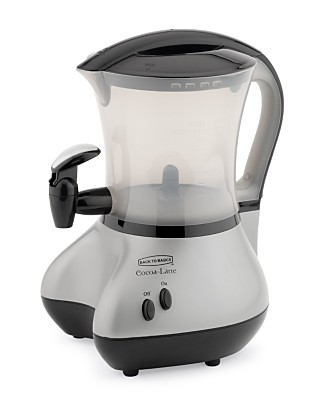I must confess however that more often than not, I will indulge daily in a cup of drinking chocolate. And more often than not, this daily cup isn't a cioccolata calda, which I've come to save for trips to Berkeley at Almare or for special occasions at home as my Italian supplies are limited.
Instead, my daily chocolate fix will be a soy-milk hot cocoa (made from cocoa powder)
or may be a soy-milk hot chocolate (made from chocolate flakes),
prepared on the stove in my chocolate pot with a thermometer,
or more like prepared in my new Cocoa-Latte machine, which mixes and froths the chocolate and milk to just the right temperature;
served in a Max Brenner chocolate "hug mug", which is shaped so that you can hug it in both hands and experience "the ultimate in chocolate coziness, warmth and fragrance."
I must admit that I do like my Max Brenner mugs, especially since I found a set of 4 on E-Bay for less than a brand new mug at full-price!
and Chocolate for Drinking: No. 1 from Montezuma's, a small, 5 shop operation, based in West Essex, with a significant range of artisan chocolates which are handmade, organic and vegan.
Both are "drinking chocolates" in that both are made from chocolate flakes, rather than cocoa powder. This means that these chocolate flakes still have the cocoa butter, which is extracted when creating a cocoa powder. There is thus a richness in flavor and texture when drinking chocolate because of the cocoa butter. Very simply, you create chocolate flakes by grating a chocolate bar, and by melting them in milk, you are "drinking chocolate."
 I had the privilege of sampling these chocolates with my cousins one evening in our own little drinking chocolate party. It was fun sampling the chocolates with different milks, using different methods of preparations, and then reviewing them.
I had the privilege of sampling these chocolates with my cousins one evening in our own little drinking chocolate party. It was fun sampling the chocolates with different milks, using different methods of preparations, and then reviewing them.We learned that coconut milk does not work. Almond milk however is not bad. But soy milk probably worked the best. (We're all veggie types, thus didn't even any cow milk on hand to try.) And in terms of methods, both my Cocoa-Latte machine as well as my cousin's espresso steamer produced similar results.
However, even though both companies won the "Great Taste Gold 2010" award from the U.K. Guild of Fine Food for their dark chocolates, none of us were very impressed with the taste of either. My cousin even said that his "poor man"-way of drinking chocolate, melting Trader Joe's dark chocolate in milk, tasted better than these expensive stuff. I would agree.
Though Hotel Chocolat's Classic Dark is made with 72% dark chocolate and claims to be "brimming with deeply authentic flavours of cocoa, for those who like their drinking chocolate not too sweet and packed with a full-on chocolaty taste," this was not our experience. We followed the measurements exactly -- 6 level teaspoons in 200 ml (or 6.76 oz or just over 3/4 cup). But there was a bland, diluted chocolate taste. And even tasting the flakes on their own, it does lack the bittersweet bite that a 72% dark should have.
While Montezuma's drinking chocolate may be only 54% dark chocolate, when sampling the flakes on their own, there was definitely more depth of chocolate flavoring and bite than Hotel Chocolat's. But when using the same measurements (6 teaspons to 3/4 cups of milk), it too tasted a bit washed out.
Montezuma's instructions
for preparation, however, were not as specific as the package suggests 3-4 teaspoons to "your favorite milk" with no amount
specified. Less milk did allow the
chocolate taste to come forward and from my taste tests, 4 teaspoons with just
under 1/8 cup of milk in an espresso cup is very nice, allowing a malty-carmely
taste in the chocolate to come through.
Though nearly half chocolate, half milk, it surprisingly did not have
the thick consistency of a cioccolata calda, but that's for another blog.
While I do enjoy drinking these fancy, expensive chocolates, I must admit that I discovered a new way of drinking chocolate that has become my new standard. It is my new drinking chocolate default and will be revealed on the blog tomorrow. It is a drinking chocolate that is less processed, less expensive, and doesn't come from a powder or flake but a bean! Stay tuned.
While I do enjoy drinking these fancy, expensive chocolates, I must admit that I discovered a new way of drinking chocolate that has become my new standard. It is my new drinking chocolate default and will be revealed on the blog tomorrow. It is a drinking chocolate that is less processed, less expensive, and doesn't come from a powder or flake but a bean! Stay tuned.











Vegan dark chocolate I think this is an informative post and it is very useful and knowledgeable. therefore, I would like to thank you for the efforts you have made in writing this article.
ReplyDelete